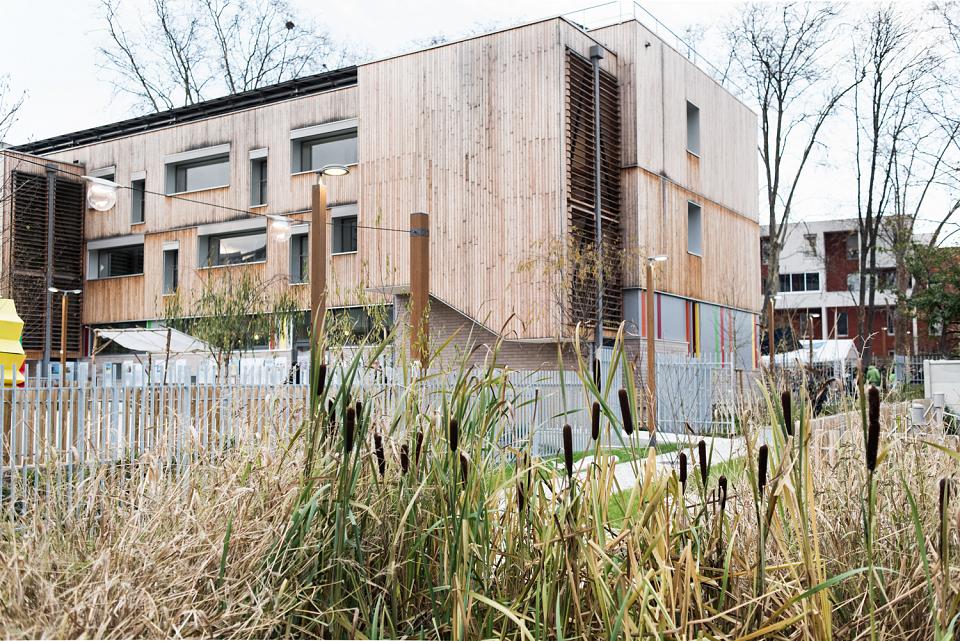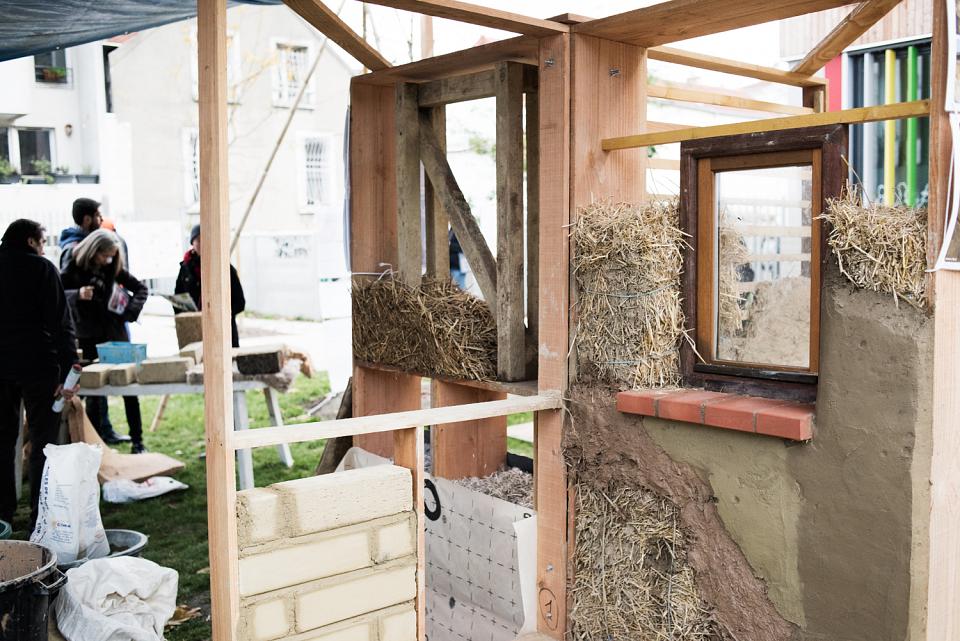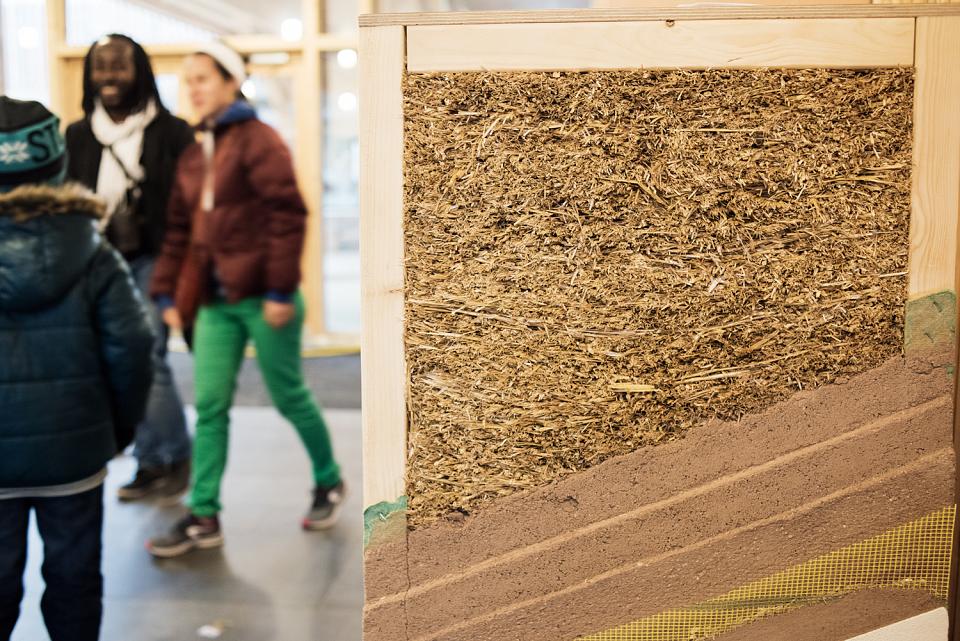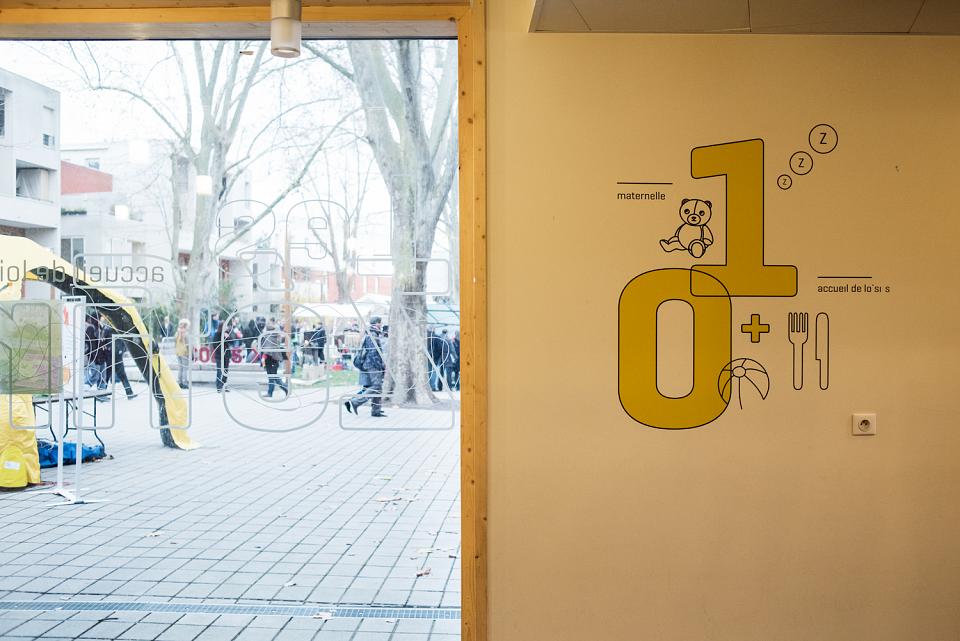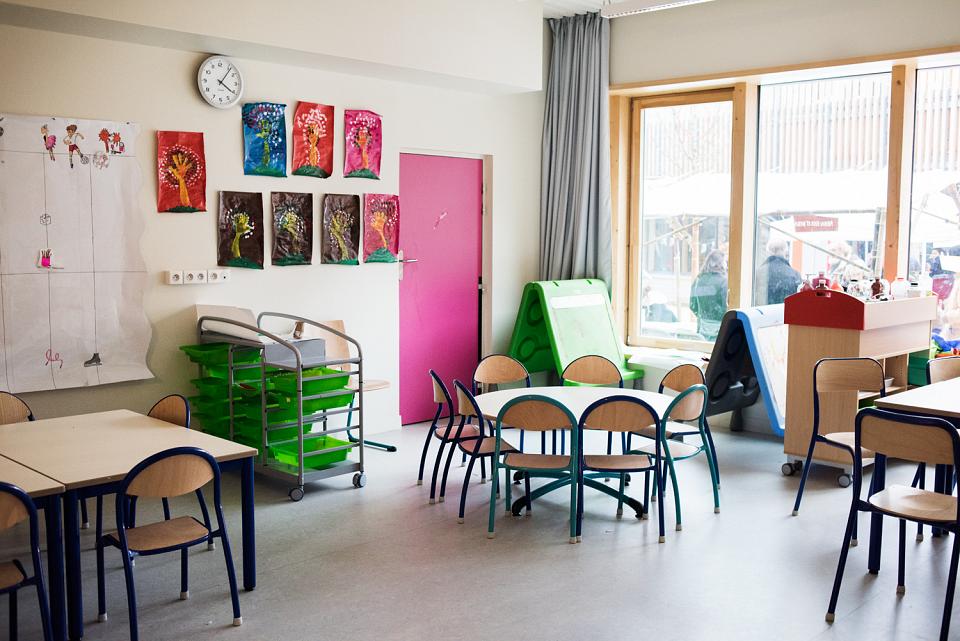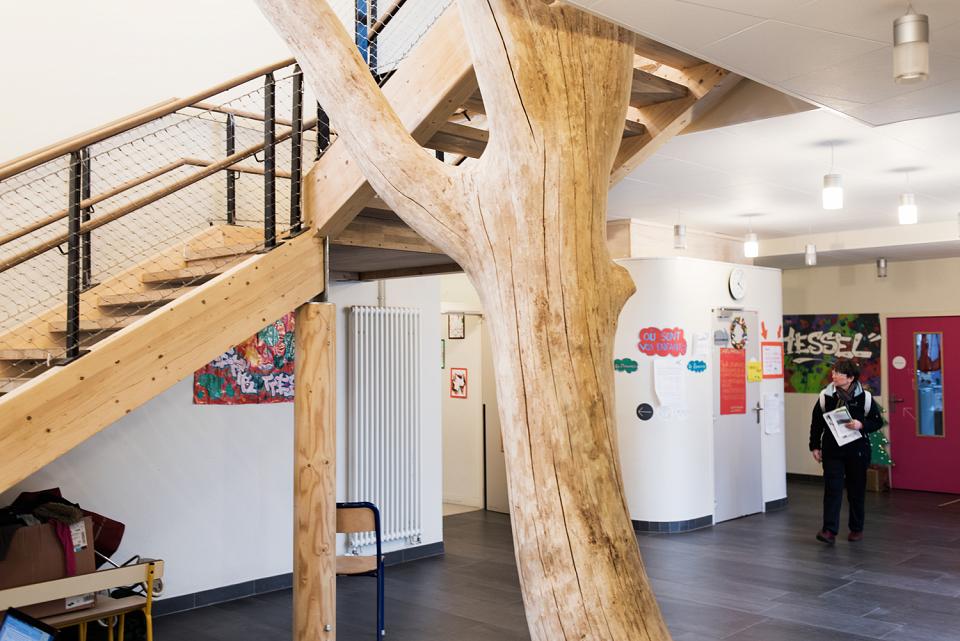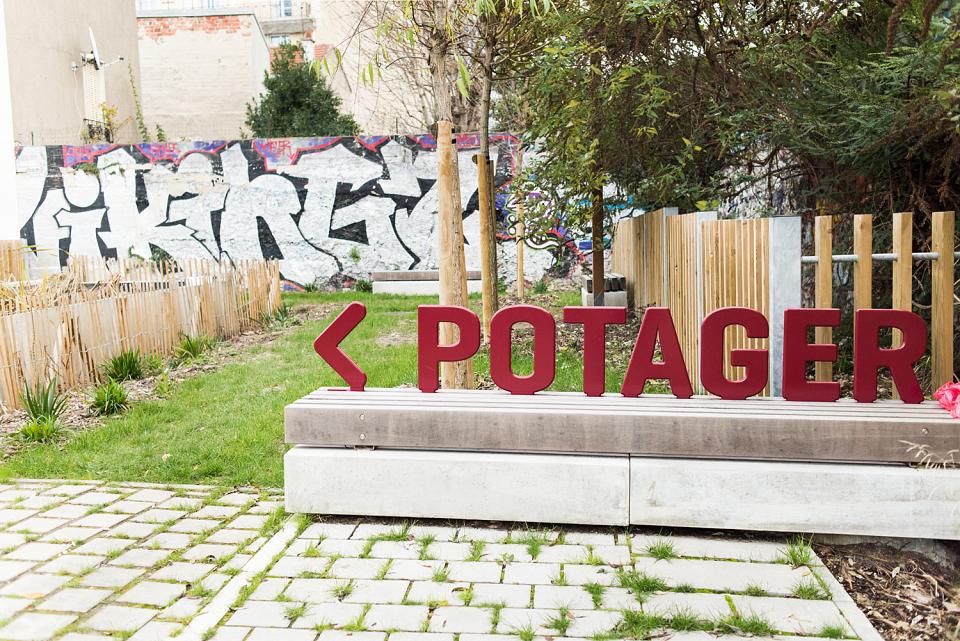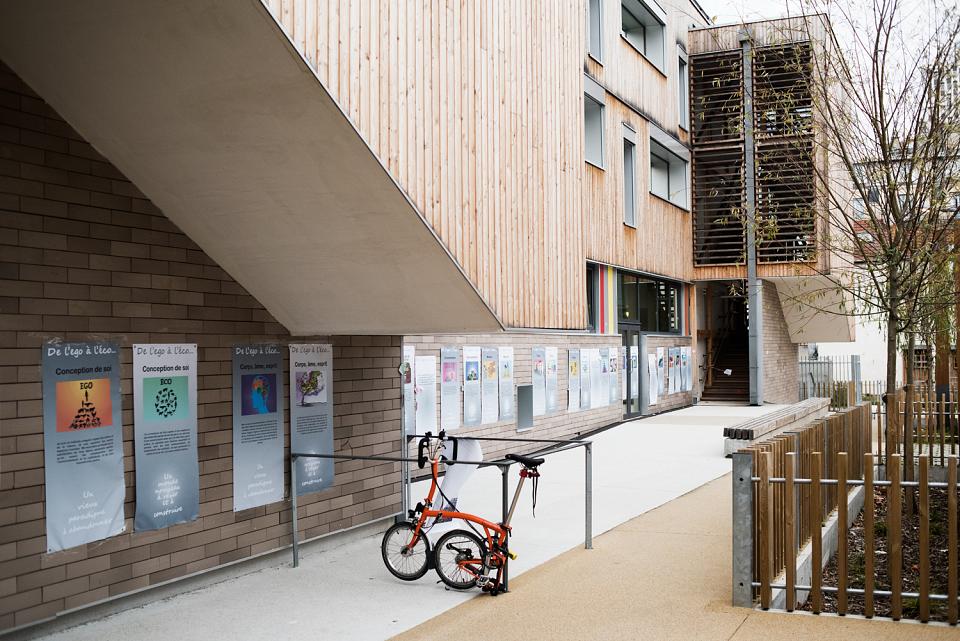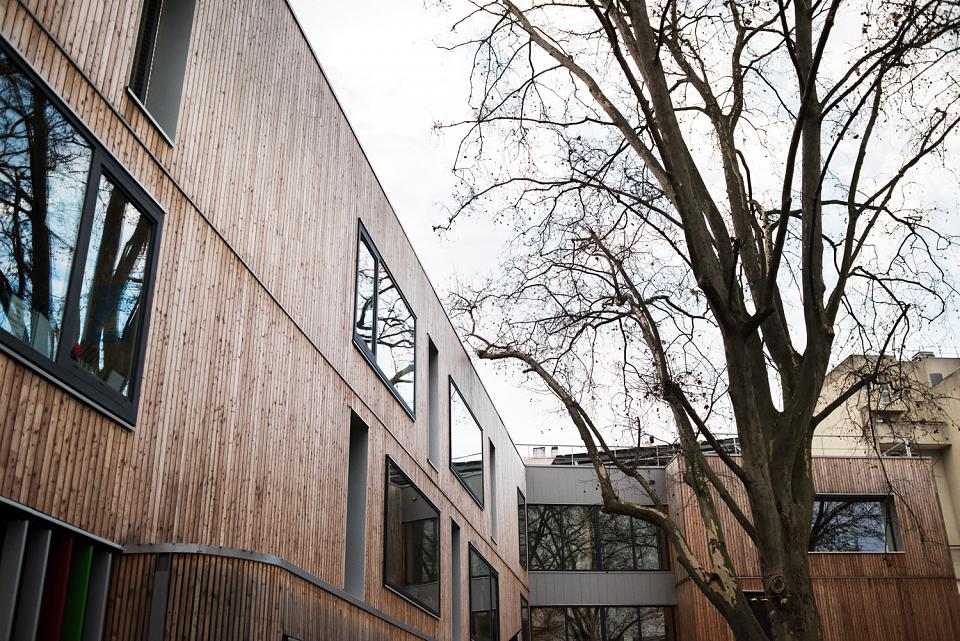This article was originally published in French. Translated by Susanna Gendall.
The morning is winding down at the drop-in day care centre in Muël, a small town of 900 inhabitants located about fifty kilometres west of Rennes in France. Ten children, aged between several months and two years, are quietly focussed on their respective activities under the watchful eyes of their supervisors. In the room next door, childcare assistants and parents talk with the early childcare educator in the “games area”, open a half-day every week. “It’s nice for kids to come here – it means they can play with games that they might not have at home,” remarks one assistant. One of the toddlers is playing with some wooden blocks, under a funny sort of window revealing the inner walls of the building, made out of . . . straw!
“This space, currently used by twelve children, is a local council community project,” states the Mayor of Muël Marcel Minier. “We always wanted the building to be environmentally friendly, and it didn’t take us long to agree on using straw.” For a long time straw was only used by people that built their own homes, as well as a few individuals that hired professional builders to help them, but straw emerged out of obscurity with the publication in 2012 of so-called “professional rules” (“Straw Bale Building Code”). The technical document, which outlines the steps involved and materials required for straw bale constructions is an “official” document, and is recognised by building professionals, authorities and insurers.
“Straw is the insulation material that has the lowest carbon footprint,” underlines Coralie Garcia, co-president of the French network of straw bale construction (réseau français de la construction en paille – RFCP). Straw is indeed the green option. “Straw is fantastic for constructing passive buildings and is also a way to reduce your energy bill – or have no bill at all. Using straw is also a way to boost agricultural activity. And there’s no need to go through a factory. It is suitable for all kinds of buildings." Straw also has a lifespan that not even concrete can compare with. The world’s oldest building with a timber frame and straw insulation was built nearly a century ago. And it just happens to be in France!
Community constructions made out of straw and earth
“The publication of this building code is a real encouragement for public clients (municipalities, regions and departments),” comments Coralie Garcia. “There is now an official text that proves the material is viable, which can be referred to when negotiating with consulting firms and insurance companies. It is usually framing companies that choose to experiment with straw.” In Muël, the construction project was coordinated by a local cooperative, Echo-paille, which teamed up with another company specialising in earth plaster. “The two companies reacted positively to the idea of a community project,” said a delighted Marcel Minier. “The idea of involving people in the project occurred to me after building the library’s earthen wall. People were very intrigued, so I thought it would be interesting to give them the opportunity to join in.”
A straw bale building is made using a wooden frame, which is erected on the site and filled with straw bales. It can also be made using prefabricated panels, which are delivered to the site already filled with straw and ready to be assembled. The people of Muël opted for the former. This involved ten days of construction work to “erect” the straw, and four days to complete the earth plastering. Forty people took part. “With community projects it’s important to find a way to encourage volunteers. The work needs to be done well, you have to find volunteers of course, and deadlines have to be met!”, says Mickaël Laurent, from the organisation “Bretagne rurale développement durable” (Rural Sustainable Development Britanny - BRUDED), which backed the project. “Faced with these challenges, many councillors can’t be bothered with it. Others decide to go for it, and are paving the way. Obviously these pioneers have to be extremely motivated.” [1]
A straw bale school right on Paris’ doorstep
It’s hard to imagine this kind of no-frills project happening somewhere like Paris, yet a straw bale school has been built in Montreuil, in Paris’ inner suburbs. “We couldn’t have straw bales sitting around outside,” said the architect Christian Haeckel. “There was the risk of vandalism, fire risks and weather issues that could damage the straw.” They decided to go for prefabricated, pre-mounted frames, stuffed with straw and waterproofed, all carried out by a company located in the region of Sarthe. Fire hazard tests were carried out in 2009 before a school was constructed in Issy-les-Moulineaux, which showed that the fire risk of this kind of building is very low. [2]
The Stéphane Hessel-Les Zéfirottes school in Montreuil, a two-storey building covering nearly 5000 m², produces more energy that it consumes. “The council required a highly energy-efficient building. Given the outstanding insulating quality of straw, we were quick to decide that this was the best material for the job,” notes Christian Hackel. Lined with Douglas fir and larch, two types of wood that grow in France and are naturally rot-resistant, the school opened its doors in September 2015. There are solar panels for water heating, photovoltaic panels for electricity, a rainwater collection system for the toilets and garden – everything in the building has been conceived to have as little impact as possible on the environment.
Out with tropical wood
“The only weak point is that vegetable oil is being used for the building’s heating and for part of the water-heating system,” points out Christian Haeckel. “Because oil is a food. But we are hoping to switch to recycled fuel with a system that collects used frying oil. Especially because the amount used by the school is very little.” In Muël, a wood-fired boiler is used for heating. “We were careful to take the health of the children into account when choosing our materials, as well as that of the people looking after them,” highlights Marcel Minier. “We used painting and decorating materials that contain no formaldehyde or other volatile organic compounds. Natural rubber, for example, was used for the floors.” Formaldehyde has been classified as a “proven carcinogen to humans” by the International Agency for Research on Cancer (IARC). Other volatile organic compounds used in paint or varnishes are just as problematic, containing components such as benzene, acetone, or perchlorethylene. [3]
Tropical wood, often used outside due to its rot-resistant qualities, is another material that the school has said no to. In Muël the fences are made out of chestnut, and the cupboards were all made by the local carpenter. “Councillors are particularly happy about the job creation aspect of this kind of project,” remarks Mickaël Laurent. “People complain a lot about unemployment in rural areas, that everyone is leaving, but people don’t think enough about the potential work opportunities created by constructive choices. The straw bale projects we are undertaking create a lot of local work.” Councils also appreciate the fact that the work sites are light on waste – no trucks piled high with junk that the community then has to deal with. “This means one less cost,” highlights Mickaël Laurent.
Straw-bale buildings considerably cheaper
The drop-in day care centre in Muël cost the local council less than €2000/m2, much less than “standard” buildings. In the town of Bouvron, a 100% green school made with mud walls cost just over €1000/m2. “Which makes it the cheapest school built in France,” note local councillors. “The school’s optimal design and the use of local materials helped to keep costs down,” remarks the organisation “Bretagne rurale développement durable”. Not to mention the low operating costs – these highly energy-efficient buildings are very cheap to run. “Buildings need to be better thought-out, simple, without superfluities,” adds Mickaël Laurent. “No unnecessary corridors, high ceilings that are there just to ‘look nice’ and complex shapes that are difficult to build – often these just hike up the bills.”
The Stéphane Hessel-Les Zéfirottes in Montreuil cost just over €2,600/m2, over-running the initial budget by 7%, which was expected. “It’s a real challenge to build a 5,400 m2 public building using unconventional techniques and materials,” remarks Christian Haeckel. “There are endless issues with the building control office. It’s exhausting. Everything has to be better than good. Everything has to be proven, demonstrated. The design has to be extremely precise, down to the last detail. Supervision of the work site is also very intensive. It’s really important to have the support and motivation of the council.” It seems that this kind of project is more straightforward in rural areas where the projects are of a more manageable size and there is a closer relationship between councils and professionals.
“But the reason more and more projects are cropping up is because some of these local councillors are real pioneers, bold enough to take the plunge before any official regulations existed,” remarks Mickaël Laurent. “They had to fight every step of the way: to get the invitation to tender underway, to get the tests checking the quality straw, in negotiations with insurance companies. They had to be very confident about what they were doing so as not get dispirited.” But with each step that is taken, everyone makes progress. “Building with straw means being brave enough to change the way one works,” sums up Coralie Garcia. “It’s so easy to just get a concrete-mixer and pour out the concrete . . .”
Nolwenn Weiler
—
Photos: The Stéphane Hessel-Les Zéfirottes straw bale school in Montreuil (Seine-Saint-Denis) / © Jean de Pena – Collectif à-vif(s)
Article written as part of a report on alternatives in the region of Île-de-France, in collaboration with the organisation Attac.


